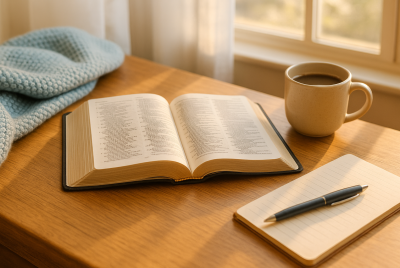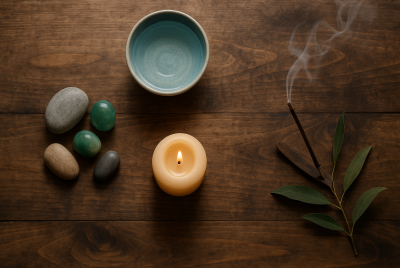7 Samhain Ritual Ideas: Honor Ancestors with Intention and Spirit
We may earn a commission for purchases made using our links. Please see our disclosure to learn more.
When life feels noisy, you crave a night that’s quiet, meaningful, and yours. That’s what a Samhain ritual gives you—gentle structure for remembering your people, releasing what you’ve outgrown, and stepping into the dark half of the year with intention. In this guide, you’ll learn exactly how to create a Samhain ritual that feels warm, grounded, and deeply personal—whether you’re brand-new or you’ve celebrated for years.
Affiliate note: I may earn from qualifying purchases at no extra cost to you.
What Is a Samhain Ritual—Really?
A Samhain ritual is a simple, intentional practice you do around October 31–November 1 (Northern Hemisphere) to mark the turning of the Wheel of the Year. Many people use it to honor ancestors, reflect on endings, and invite guidance for the season ahead. Think candlelight, favorite recipes, photos on a small altar, and a few mindful steps that help you move from “busy” to “present.”
A Kind Reminder on Culture & Respect
Samhain has roots in Celtic traditions. Today, people from many backgrounds celebrate in inclusive, modern ways. Be thoughtful with cultural elements: choose practices you have permission to use, credit sources, and opt for universal actions (candles, letters, gratitude, music) if you’re unsure. Your Samhain ritual should honor both your heritage and your values.
Prep Your Space: Safety & Intention
Keep it cozy, not complicated.
- Clear a small surface (shelf, tray, table).
- Add a cloth, a candle, a photo, and one natural item (apple, leaf, stone).
- Open a window if you plan to burn paper or herbs.
- Place water or sand nearby for candle safety.
- Whisper a one-line purpose: “I’m here to remember with love and welcome a steady season.”

Ritual #1: Candlelight Ancestor Vigil
Let a single flame do the heavy lifting.
What you’ll need
- One candle (beeswax if possible), a photo or heirloom, and a few quiet minutes.
Simple steps
- Light the candle and say the names of those you’re honoring—aloud or in your heart.
- Share a favorite memory. Smile if you can.
- Ask: “What strength did I inherit from you that I can carry forward?”
- Sit for 3–10 minutes. If tears come, they’re welcome here.
Make it your own
Play their favorite song, set out their tea, or write a short message on a slip of paper and place it beneath the candle holder.
Ritual #2: Memory Plate & Harvest Dinner
Set an extra plate as a symbolic welcome. Serve a simple autumn meal—roasted squash, root veggies, fresh bread, cider. Before eating, say one sentence of gratitude: “Thank you for the love that shaped me.” If you’re with family, invite everyone to share a story.
Ritual #3: Letter to the Departed (Burn & Release)
Write a letter to someone who’s passed—or to an old version of you. Say what you couldn’t say. Fold the page. If it’s safe, burn it in a fireproof bowl, watching the smoke carry your words away. Breathe. Then say: “May this be held with love.”
Ritual #4: Threshold Blessing (Protect & Welcome)
Stand by your front door. Sprinkle a pinch of salt along the threshold or mist the air with water scented by rosemary or orange peel. Say: “Only what serves peace may enter; only what needs release may leave.” Placing a tiny wreath or dried herb bundle on the knob adds a sweet touch.
Ritual #5: Divination Quiet Hour
If you use divination (tarot, oracle, runes, scrying), set a 20-minute timer. Pull a single card with this prompt: “What wisdom will carry me through the dark months?” Journal what you notice—colors, shapes, feelings—without chasing “perfect” answers.
Ritual #6: Shadow Work, Gently
Samhain invites us to look at what we hide. Try one prompt:
- What am I ready to stop pretending about?
- Where am I braver than I admit?
- Which habit has finished its job—and how will I thank it as I let it go?
Write for 10 minutes. Close with one compassionate action you’ll take this week.
Ritual #7: Dawn Gratitude Walk
On November 1, take a short walk. Notice one thing that’s ending in nature—dry leaves, colder air—and one thing still growing—late flowers, hardy herbs, morning birds. Whisper: “I am part of this turning too.” Pick up a single leaf for your altar.

Grounding with Prayer or Scripture Meditation
If you draw strength from faith-based practice, end your Samhain ritual with a few minutes of scripture and stillness. Here’s a gentle companion on how to meditate on God’s Word if you’d like a simple, heartfelt approach to quiet time and reflection: a friendly guide to scripture meditation.
Amazon Products for Your Samhain Ritual Toolkit
Below are five widely loved items that integrate beautifully with a Samhain ritual—kept practical, budget-aware, and beginner-friendly.
1) Root Candles 12-Inch Unscented Tapers (Beeswax-enhanced)
Why it’s great: Long, steady burn for ancestor vigil nights; classic look for any altar.
Features: 12″ length; drip-resistant; natural, lead-free wicks; approx. 1.5 hours burn per inch.
Pros: Clean burn, elegant glow, easy to pair with holders.
Cons: Tapers require a snug holder; beeswax-enhanced blends can cost more than basic paraffin.
Best for: Anyone wanting a simple, refined flame for remembrance.
Review snapshot: Shoppers praise reliable, even burning; occasional notes mention fit issues with loose holders.
2) New Age Imports Cast Iron Cauldron (4–4.5″, Lid & Handle)
Why it’s great: Fire-safe bowl for paper releases, charcoal incense, or salt water.
Features: Cast iron; lid & handle; compact footprint; sizes around 4–4.5″ high/4″ diameter.
Pros: Durable, heat tolerant, multipurpose.
Cons: Cast iron is heavy; can leave marks on delicate surfaces—use a trivet.
Best for: Burn-and-release letters; charcoal/resin incense in a controlled vessel.
Review snapshot: Buyers like sturdiness and lid; a few mention small interior depth—good for modest amounts.
3) U.S. Games Systems Original Rider-Waite® Tarot
Why it’s great: The classic deck many readers learn on; straightforward symbolism for seasonal pulls.
Features: 78-card deck; guide booklet; original Pamela Colman Smith art.
Pros: Timeless imagery; abundant learning resources online and in print.
Cons: Standard cardstock; some prefer modern or diverse decks.
Best for: Beginners wanting a dependable, widely referenced deck.
Review snapshot: Consistently praised as the go-to starter; occasional critiques of card finish.
4) The Ohm Store Tibetan Singing Bowl Set (3.5–4″)
Why it’s great: A few mindful strikes settle the room before vigil or journaling.
Features: Hand-hammered bowl; wooden striker; cushion; compact size for desks and altars.
Pros: Soothing tone; small and portable; artisan-made feel.
Cons: Technique matters; takes a few tries to avoid “chatter.”
Best for: Opening/closing ritual space; transitions between sections.
Review snapshot: Buyers love rich resonance and giftable packaging; a few note a learning curve.
5) Moonster 7×5″ Leather Journal
Why it’s great: A beautiful place for letters, prompts, and Samhain reflections.
Features: 7×5″ size; thick paper; options for lined/blank; rustic leather cover.
Pros: Portable; thoughtful gift; pages resist heavy ghosting.
Cons: Leather patina varies; some editions are non-refillable.
Best for: Shadow work, dream notes, seasonal intentions.
Review snapshot: Loved for feel and durability; some wish for page markers or pockets.
Quick Comparison Table
| Model | Key Spec(s) | Warranty* | Approx Price/Tier | Best For |
| Root 12″ Unscented Tapers | Beeswax-enhanced, 1.5 hr/inch burn | Not stated on page | $$ | Ancestral candle vigils |
| New Age Imports Cast Iron Cauldron | 4–4.5″ size, lid & handle | Not stated on page | $$ | Safe burn/release, charcoal resin |
| Original Rider-Waite® Tarot | 78 cards, guide booklet | Not stated on page | $–$$ | Clear, classic divination |
| The Ohm Store Singing Bowl | Hand-hammered, striker + cushion | Not stated on page | $$ | Opening/closing ritual space |
| Moonster 7×5″ Journal | Thick paper, leather cover | Not stated on page | $–$$ | Shadow work & letters |
*If warranty matters to you, double-check the product page just before purchase; policies can change.

Research-Backed Benefits of Ritual (So You Feel Grounded, Not “Woo”)
Rituals aren’t just vibes—they’re psychology at work. Two solid findings you can lean on:
- Rituals can ease grief by restoring a sense of control. A 2014 paper by Norton & Gino found that after various losses, ritual participants reported less grief, and the mechanism was increased perceived control. That’s why a simple candle and a name can feel like a steadying hand.
- Rituals help regulate emotions, goals, and connection. An integrative 2018 review summarized evidence that rituals support emotional regulation, shape goal states, and strengthen social bonds—useful lenses for designing your Samhain ritual: soothing the heart, clarifying intentions, and centering community.
(If you’re curious, related work also explores neural responses during ritualized action—why structured steps can buffer the sting of mistakes and anxiety. Interesting, right?)
Safety & Ethics Tips (Because Care Is Part of the Magic)
- Fire safety first. Avoid leaving any flame or smoldering item unsupervised. Use holders that fit, keep hair/sleeves back, and place on a heat-safe surface.
- Scent sensitivity. If smoke bothers you or anyone at home, choose water, bells, sprays, or flowers instead.
- Eco-kindness. Compost offerings (fruit, leaves) instead of leaving them outdoors where they could harm wildlife.
- Consent & privacy. If you mention living relatives, share with care—your ritual journal is your safe container.
Samhain Ritual Flow (A One-Hour Template)
- Open (5 min): Ring a bowl or take three slow breaths. Name your intention.
- Honor (15 min): Candlelight vigil and a memory.
- Release (10 min): Letter to the departed or to an old habit; burn or tear safely.
- Listen (15 min): One tarot/oracle pull + a few lines in your journal.
- Close (5 min): Sip warm tea, speak gratitude, and snuff the candle (don’t blow if you prefer to “seal” the work).
- Integrate (10 min tomorrow): Morning gratitude walk with one takeaway you’ll act on this week.
Common Pitfalls (And Friendly Fixes)
- “I don’t feel anything.” That’s okay. Feelings aren’t a pass/fail. Keep it small, consistent, and compassionate.
- “I have no fancy tools.” A tea light, a pen, and a leaf are enough. Ritual = meaning + attention.
- “What if I mess up?” You can’t. If something drops or smokes too much, pause, laugh, reset. The season welcomes imperfect humans.
FAQs
How do I start a Samhain ritual if I’m brand new?
Begin with one candle, one photo, and one sentence. Light, remember, and breathe. Add layers next year. The simplest rituals often land the deepest.
What do I put on a Samhain altar?
Photos, names, favorite foods (small portions), seasonal items (apples, leaves), a candle, a bowl of water, and something from your own story—like a locket, recipe card, or ticket stub.
Can I honor ancestors if I never knew them—or if family is complicated?
Yes. You can honor the wise and loving forces you choose—biological, adoptive, chosen family, mentors, or cultural ancestors. Boundaries are sacred; invite only what feels safe.
Is smoke cleansing required?
No. You can ring a bell, sprinkle salt water, place fresh flowers, or open a window. Choose options aligned with your health, values, and cultural respect.
What if I celebrate with kids or a mixed-belief household?
Keep it values-based: gratitude, storytelling, kindness for those we miss. Kids love placing leaves, lighting LED candles, and sharing one “superpower” they got from an ancestor.
Closing Blessing
Samhain is a threshold—darkness arriving, yes, but also rest, warmth, and wisdom. May your Samhain ritual be tender, honest, and exactly enough. Light one small flame, tell one true story, and carry one simple intention into the season. You’ve already begun.




